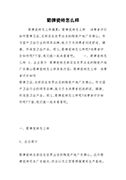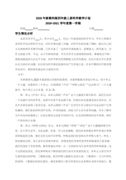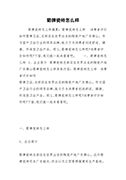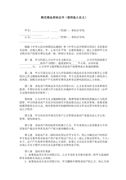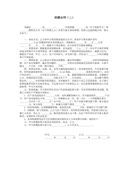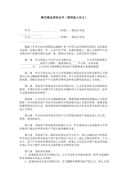说课:《牛津小学英语》5B Unit7 A busy day Part A(精选15篇)五年级英语教案
说课:《牛津小学英语》5B Unit7 A busy day Part A(精选15篇)
说课:《牛津小学英语》5B Unit7 A busy day Part A 篇1
good afternoon, everyone. i’m fan jiayin. i come from dongzhongshi experimental primary school. it’s my great pleasure to be here sharing my lesson with you. the content of my lesson is “a busy day” part a from unit 7,fun with english 5b.
一.teaching contents
the topics on fun with english are well organized focusing on the pupils’ world. unit 7 is intended for pupils to talk about their daily lives. they have learnt many verb phrases. such as watch tv, have breakfast, clean the library, watch a football game, do homework and etc. you know they are bilingual class pupils, so maybe these phrases will be more easier for them. “a busy day” mainly talks about the time and what they should do at the time.
considering the contents of the lesson and the levels of the pupils, i design the following teaching aims.
二、teaching aims
1. aims on the knowledge: pupils will learn the new words “busy, past, to, on duty, brush teeth, really, half, a quarter ”, the new structures “ what time is it? it’s time for… do you want to…? i want to…
2. aims on the abilities: to develop pupils’ abilities of listening ,speaking, reading and writing. to develop pupils’ communicative skills
3. aims on the emotion: to develop pupils’ sense of co-operation. to let pupils know they should cherish the time.
三、important points:
1. to help the pupils say the new words and use the key sentences correctly.
2. to write whole sentences correctly.
四、difficult points
1. how to make dialogues and act them out.
2. pupils can talk about the time and what they should do at the time.
五、teaching aids
and in this lesson we’ll need cai , tape recorder, school things and so on.
六、teaching methods
now i’d like to talk about my way of teaching(不必写在教案里).
1. communication method
i’ll set up a real situation, in this way , pupils can practise in pairs or in groups, they can speak freely and needn’t worry about making mistakes
2. task-based method
that is to say i’ll let the pupils finish a task by making a short dialogue and acting it out. to help the pupils get a better understanding of the key structures, i will arrange these kinds of activities: singing, guessing game, finishing a survey and having a competition.
七、learning methods
let pupils study in a relaxed and agreeable atmosphere. thereby, develop the pupils’ abilities of studying and working with the learning language independently.
八、teaching procedures
now i’ll mainly talk about my teaching procedures. i’ll follow five steps.
step 1( warm-up and revision)
it is important to set up a better english learning situation for the pupils . so i ‘ll design
activity 1. sing a song: do some exercise with me? this song is from unit6
activity2. tpr( total physical response ) to ask pupils to follow my instructions, “get up, have breakfast, watch tv, do homework” then ask and answer: what are you doing? i am…
t: look, what am i doing?
present the new phrases: brush my teeth
t: who is on duty today?
let the child give the orders which are on the paper.
i design this activity to get pupils to warm up and review the present continuous tense. i also infiltrate two phrases in this step, “brush my teeth, on duty”. because they will be presented in the text.
step 2 (presentation )
to present and practice the key structures one by one, that’ll be much easier for the pupils to learn and grasp the meanings. so in this step, i’ll design 3 activities.
activity1: guess and learn.
guess a riddle, then learn to express time in english. in this step, i will use cai to help me with my teaching. let children practice the time first. then learn to use “past” and “to”
activity 2: ask and answer. what time is it? it’s time for…
let pupils talk about the time : what time is it? it’s time to… because pupils have already learned this structure .then teacher can make a model first : it’s time for… then practice in groups.
as we all know, using the pictures, this is one of the easiest ways to show the meaning of the words and sentences.
activity 3: talk and match
talk about the time and the things first, then listen and match . if time is enough, pupils can talk about their own time and their own things.
children’s attention span is very short. and proper exercises can help pupils focus on their attention and practice the key structures better.
activity4: think and say
t: oh, what time is it now? it’s time to watch vcd. do you want to watch vcd?
s: i want to watch vcd.
teacher shows them a list, look at the time and things: what do you want to do? then invite your friend: it’s … it’s time for… i want to … do you want to…?
in this activity, pupils are encouraged to put themselves in the situation and make a face to face talking. all the pupils are involved in this activity. they can talk as much as possible.
step3. (production)
to help pupils put the language into using, i design a task to help pupils have a production.
first watch vcd. let the ss listen and imitate the dialogue. pay attention to their pronunciation and intonation. at last i’ll ask the pupils to think hard and act it out. then find out which group will act it out well. i’ll give them red stars.
purpose of my designing: this step makes the pupils get the general idea of the dialogue as a whole one. at the same time let the pupils have a chance to practise their listening and spoken ability.
step 4. (consolidation)
to develop pupils’ abilities of listening and speaking, that’s the main instructional aims of learning english in primary school. so in step 4, i’ll design some listening exercises to check what they have learned. for example: think and fill in the blanks. everyone will have a piece of paper. in this step i’ll give the pupils a free space to show their abilities.
purpose of my designing: “task-based” teaching method is used here to develop the pupils’ ability of communication and co-operation. tell the pupils we should cherish our time, time and tide wait for no man.
step 5. (homework )
after step 4, some pupils can grasp the knowledge well, but some pupils can’t. revision is so important, pupils should speak english after class as much as they do in class. it is necessary for the pupils to do some exercise after class. so i design the following homework.
1.listen and read.
2.try to talk about the pictures.
3. try to finish your timetable
my timetable
time
time
what for?
6:30
half past six
it’s time for breakfast.
九、.blackboard design
unit7 a busy day
what time is it? busy 繁忙
it’s … past… on duty 值日
it’s … to … brush teeth 刷牙
it’s time for…
do you want to…?
i want to…?
proverb: time and tide wait for no man. 时间不等人。
in a word, the teaching of this lesson aims to develop not only the pupils' language abilities, but also the diverse intelligence. as eachers, to make our english classrooms shine with vitality, we still have a long way to go.
above is the lecture notes of my lesson. thank you!
说课:《牛津小学英语》5B Unit7 A busy day Part A 篇2
一 教学目标
1 能听懂、会说、会读和会拼写单词a car, a bike, a bus 和 a kite。
2 能听懂、会说、会读和会写句型 what’s this/that in english? it’s a… do you like…? yes, i do. /no, i don’t.
3 能听懂、会说和会读日常交际用语 i loke puzzles. me, too. i love dolls. thank you very much. look at my kite. it’s nice. let’s…
4 初步了解名词的单复数。
5 了解辅音字母j 和 k 在单词中的发音。
6 能诵读歌谣 fly, fly my kite.
二 教学重难点
1能听懂、会说、会读和会拼写单词a car, a bike, a bus 和 a kite。
2能听懂、会说、会读和会写句型 what’s this/that in english? it’s a… do you like…? yes, i do. /no, i don’t.
三 课时安排:5课时
第一课时
教学内容:《牛津小学英语》4a unit 4
一 教学目标
1能正确听说读写词语in english, do, you, like, don’t, love, a puzzle, a kite, a doll.
2能正确运用日常交际用语 what’s this/that in english? it’s a puppet. do you like puppets? 及其回答 yes, i do./ no, i don’t.
3初步认识名词的单复数的基本形式。
二 教学重难点
1能正确听说读写词语in english, do, you, like, don’t, love, a puzzle, a kite, a doll.
2能正确运用日常交际用语 what’s this/that in english? it’s a puppet. do you like puppets? 及其回答 yes, i do./ no, i don’t.
3正确朗读单词 puppet, puzzle.
4比较流畅地朗读本课对话,并能在掌握本课对话内容的基础上用比较正确的读音、语调、表情和动作表演对话。
三 教学准备
1磁带和录音机。
2准备 puppet puzzle kite 和 doll等玩具和图片。
3新单词卡片 a kite, a doll, a puppet, a puzzle, love.
4请学生准备一些文具用品、玩具,要求色彩鲜明。
四 教学过程
a . free talk :
1. good morning/afternoon. / how are you?
2. t: hello.
s: hello, miss fan.
t: what’s that on your desk?
s: it’s a dog.
t: can i have a look?
s: sure.
t: oh, i love your dog.
…
b . presentation and practice
1.介绍生词
1)拿出玩偶说it’s a puppet,跟读。
2)show these toys to the ss and stick them on the bb.
2.介绍句型
1)t point to her toy and say, this is a … let ss introduce their toys with these sentences’ this is a …’ ‘that is a…’
2)t: what’s this /that in english?
s: it’s a ..
3)ss pratice the sentence with their toys. s----ss
4)t write down the sentences.
3.介绍名词单复数,生词like love和句型do you like/ love…?及其回答
1)t point to the toy and say, a puzzle---puzzles---i like puzzles.
2) ask the puppet: do you like puzzles?模拟回答 yes, i do./ no, i don’t.
3) the puppet ask t: do you like …? tell ss the differences between like and love.
4) ss practice.
c. read andsay
1.look at the pictures carefully and listen to the tape. guess are these sentences right?
yang ling is in nancy’s home.
yang ling and nancy like puppets.
they like kites.
yang ling and nancy like puzzles.
they don’t love dolls.
2.学生听录音,模仿。
3.自读课文。
4.分角色读。
5.师生分角色读。
6.同桌练习,表演。
7.上台表演。
d. consolidation
game t:what’s this…?
s:it’s a … (guess)
t:do you like this…?
s:yes, i do. i love…
t:here is a … for you.
s:thank you.
e.assign homework
1. 听录音,朗读,表演。
2. 自编对话。
第二课时
教学内容:《牛津小学英语》4a unit 4
一 教学目标
1.能正确听说读写单词a car a bus a bike a kite.
2. 能正确听说读单词 a balloon.
3. 能正确听说读写句子 what’s this/that in english?及其回答it’s a …
4. 能朗读歌谣fly, fly my kite
二 教学重难点
1. 能正确听说读写单词a car a bus a bike a kite.
2.能正确听说读单词 a balloon.
3. 能正确听说读写句子 what’s this/that in english?及其回答it’s a …
三 教学准备
1.准备八张图片及相应的单词卡片,录音机,磁带。
2.让学生准备自己的玩具。
3.板书准备。
四 教学过程
a.free talk
t: look,boys and girls. what’s this in english? (木偶)
s: it’s a puppet.
t: do you like puppets?
s:yes, i do. no, i don’t.
教师继续出示其他图片,替换示范。学生练习。
b. bevision
1. review read and say, act it.
2. 复习单词a puppet a puzzle a doll, 学生贴图片。
c. look read and learn
1. (气球) t: look at this picture. what’s this in english? oh, it’s a balloon. it’s red. it’s a nice balloon. do you like balloons?
ss: yes.
t: now read the word ‘balloon’ after me. can you put it on the bb?
2. play a game: what’s missing?
3. t:look at the picture. what’s this in english?
ss: it’s a car.
t: now let’s read andc spell the word ‘car’ (twice)
t:who can put it on the bb?
同法教其他单词。
4. play a game what’s missing?
这次要求拼写单词。
d. work in pairs
1.t: look here. what’s this in english?
ss: it’s a pen.
t: what’s that in english?
ss: it’s a book.
学生朗读,书写,抄写。
2. work in pairs.
e. say a rhyme
1. 听录音,欣赏
2. 介绍大义,朗读。
f. assign home work
1. 抄写四会单词和句子。
2. 朗读并默写四会单词和句子。
第三课时
教学内容:《牛津小学英语》4a unit 4
一 教学目标
1. 通过复习,掌握本单元的单词和句型what’s this/that in english?及其回答。
2. 进一步掌握句型do you like…? 及其回答。
二 教学重难点
1. 能四会掌握do you like… 及其回答。
三 教学准备
1.磁带 录音机 幻灯 玩具 图片
2.统计表
四 教学过程
a. free talk
1. say a rhyme
2. free talk
b. revision
t: now let’s review some words and sentences.
what’s this in english?
ss: it’s pen.
t: do youlike pens?
ss: yes, i do.
t: me, too.
同样的方法复习所有单词。
c. work in pairs
1. 出示表格ask and answer
name
kites
图
puppets
图
puzzles
图
dolls
图
s1
s2
示范,练习
2. practice in groups
3. report
1) how many ss like…?
2) who are they?
d. look and read
1.观察图片,了解大意
2.听录音,读故事
e. assign homework
1. 默写本单元的单词。
2. 用do you like…? 了解别人对物品的喜欢与否。
第四课时
教学内容:《牛津小学英语》4a unit 4
一 教学目标
1. 通过复习,掌握本单元所学的单词和句型。
2.能比较熟练地在情景中运用句型和交际用语。
3.能初步了解辅音字母j k在单词重的发音。
4.能有节奏地朗读歌谣。
二 教学重难点
1.能综合运用本单元的单词和举行。
2.能正确拼写玩具类的单词。
三 教学准备
1.磁带 录音机 实物投影仪 玩具 六种颜色牌子 水彩笔
2.学生带好玩具河水彩笔
四 教学过程
a. say a rhyme.
b. free talk
t: look! what’s this in english?
s: it’s a car.
t: do you like cars?
s: yes, i do. …
t: here’s a car for you.
学生用自己的玩具操练。
c. read and act
1. 出示风筝的头影片
t: what’s this in english?
ss: it’s a kite.
t: … come here ,please.
s1: all right.
t: look at my kite. do you like it?
s1: it’s nice. i like it.
t; let’s color it.
t: do you like red? …
2. 听录音两遍
3. ask and answer: whose kuite is it? do you like it?
4. 跟读 学生轻声读 同桌分角色读 出示投影编对话。
d. listen and repeat
1. t : now let’s look at this picture. ( jim juice key kitchen)
ss: 跟说这四个单词,体会。
2. 含有j k的单词 jacket jogging kite
e. play a game
1. 六个人带六种颜色,老师说i like red.有红色的学生把牌子给老师,然后他发口令。
2. 组内玩游戏。
3. 输了说歌谣。
f. assign homework
1.抄写本单元的单词和句型,默写。
2. 背诵并表演read and act
3. 自编对话。
说课:《牛津小学英语》5B Unit7 A busy day Part A 篇3
教学内容:《牛津小学英语》6b unit 8 part c look and talk 练习册part d
教学目标:
1、通过复习,熟练掌握unit 6 的四会词汇及句型。
2、掌握unit 8 c部分出现的词汇短语。
教学重点:
1、熟练掌握unit 8 c部分出现的单词、短语。
2、能自由、准确地运用英语谈论自己的打算。
教学难点:自由运用语言谈话自己的打算。
教具准备:录音机、多媒体画面、转盘。
教学过程:
step1 warm up
1. greetings
2. sing a song “will you join me?”
step2 revision
1. play a game.
a. 师出示c部分的多媒体画面,两人合作,选择自己喜欢的俱乐部,其中一人比划动作,另一人猜出所代表的短语,在规定的时间内完成任务可为本组赢得一个笑脸,教师及时给予评价。
b. 小组比赛朗读这些短语。
2. free talk.
t: children’s day is coming. what are you going to do at children’s day?
s1: i’m going to…… would you like to join us?
t: yes, i’d love to.
s2: i’m going to……
step3 look and talk.
1、同桌看图,讨论图中人物的对话。
2、学生根据自己的爱好分别加入四个俱乐部,利用句型what are you going to do
this afternoon? i’m going to ……with my friends, would you like to join us? yes, i’ d love to进行交流。
3. play a game .两人一组,转动转盘,根据指针所指到的短语进行对话。
4. step 4 look, match and write.
完成练习册part d
1. look at the picture. who are they?
2. work in pairs.
what is ben/ liu tao / jim / helen / gaoshan going to do ? he / she is going to ...
what are su hai and su yang going to do ?
they ‘re going to ……
3. complete the sentences.
4. ask some students write on the blackboard.
5. read the sentences together.
step 5 homework
1. unit8 c部分任选四幅图自编对话写下来。
2. 利用句型what are you going to do at children’s day?调查自己的10位朋友,记录下来,并统计出六一儿童节最受大家欢迎的活动。
板书内容:
unit 8 review and check.
what are you going to do this afternoon?
i’m going to ……with my friends. would you like to join us ?
yes. i’d love to.
板书设计:
说课:《牛津小学英语》5B Unit7 A busy day Part A 篇4
一、教材分析:
《牛津小学英语》3a教材按“话题---功能---结构---任务”相结合的原则编写,内容贴近小学生的生活和学习实际。倡导教者从视听说入手,通过听、说、读、写、演、唱、画等丰富的语言实践活动,帮助学生获得良好的语音基础、初步的语感和用英语进行简单日常交流的能力。并培养学生的学习兴趣、学习自信心和良好的学习习惯,形成有效的学习方法和自主学习能力等。
根据英语课程标准,对教材进行灵活处理,本节课把unit 2.part b、d两部分组合成一个课时的教学内容,主要学习red、yellow、blue等八种基本颜色的单词,并运用句型what color is it? it’s…进行简单描述,让学生能将所学的语言知识与生活实际联系起来,真正运用到今后的生活和学习中去。
二、学生分析:
三年级的学生大都天真活泼,有强烈的求知欲。他们初学英语,对英语课有浓厚的兴趣和向往,在课堂上表现积极大胆、乐于实践,而且善于模仿,因此教师要把握好这一契机,通过组织丰富多样的教学活动来让学生充分体验语言实践的成功喜悦和信心,从而优化教学效果。但是,他们大都好动贪玩,有意注意时间还比较短,因此在课堂上教师也要注重运用激励和引导,把握好教学活动秩序的“松弛度”。
三、教学目标:
1、语言知识目标: 能听说、认读八种颜色的单词red,yellow,blue, green, orange,brown,black,white 。
2、语言技能目标: 能用句型what color is it? it’s…进行简单的物体颜色描述并能真正运用到生活中。
3、意识和情感目标: 培养学生的审美情趣和创新精神;让学生在活动中体验互帮互助的乐趣,培养学生的合作能力。
4、学习策略:从学生的学习和生活实际入手,融语言于情景之中,鼓励亲身实践;利用学生的信息差,通过同学间的合作,使学生在活动中手、脑、口、眼并用,加深学生对语言知识的记忆和运用。
四、教学策略:
1、教学方法:情境教学法、活动教学法和任务型教学。
2、教学手段:flash课件,录音机、单词卡片,八种颜色的卡纸,服装卡片,调好各种颜色的水数杯,大烧杯两个,小书签(作奖品用)。
五、教学过程:
i. warming-up
1、听录音唱英文歌曲《hello!》。
2、free talk
t: good morning s1: good morning,mr xie.
t: what’s your name? s1:my name is…
t: nice to meet you. s1: nice to meet you ,too.
【 通过师生唱英文歌曲和简单的问候,创设浓厚的英语氛围,并自然复习了之前所学的交际用语。】
ii.presentation
1、通过课件的动画显示,整体呈现新授内容,并用八种颜色的卡通小朋友来逐个呈现新授单词:
红色的卡通小朋友从集中的画面跳出: hello,i am red. red,red,red,i am red.→教师出示带颜色的单词卡片→反复领读单词。
2、让学生和八个颜色卡通逐个交朋友,动画显示:hello,i am red. nice to see you.引导学生说:hello! nice to see you, red .
(同样的方式呈现另外七个单词)
【 利用flash动画生动呈现语言知识,让学生获得感性认识,同时自然的结合了新旧知识。】
3、出示八种颜色的卡纸,逐个领读数遍(t:red, it’s red .),然后顺势呈现句型:
t:what color is it?
ss:red.
t:yes. it’s red.
(同样的方法用另外七张卡纸呈现,然后板书句型what color is it? it’s…)
4、以开火车或分组比赛的形式,用八种颜色的卡纸反复进行问答练习,初步识记所呈现的单词和句型。
【 将单词与句型的教学相结合,词不离句,即学即用。】
5、做实验,猜颜色。
教师出示一杯用颜料调好红颜色的水,
t: what color is it? ss: it’s red.
再出示一杯用颜料调好黄颜色的水,
t: what color is it? ss: it’s yellow.
将两种水进行适量的混合(教师像魔术师一样夸张神秘的动作),
t: what color is it? ss: it’s orange.
( 同样的方法进行黄与蓝、红与黄等调色的尝试 )
【 让学生结合美术常识仔细观察教师实验后回答问题,既为学生创设了感知和操练语言知识的情景,又培养了学生的观察力和注意力,学生的兴趣十分浓厚,教学效果不言而喻。】
6、看课本并跟录音朗读,检验和纠正学生的发音。
iii. practice and consolidation
1、快速竟猜游戏:屏幕高速闪动一动物的画面,让学生用英语猜一猜每个动物的颜色,对猜对的学生给予奖励。
【 竟猜游戏是孩子喜闻乐见的活动,活动时学生的注意力高度集中,充分调动了学生的积极性,将知识机械操练情趣化。】
2、小小设计师:小组同学齐动手,把不同的服装卡片(课前给每小组发四张)涂上自己喜欢的颜色,然后小组间相互展示或上台介绍(要求用句型it’s red/blue…)
【 动手操作与语言实践相结合,让学生学会欣赏颜色与美,同时体现英语教材与跨学科知识的整合。】
3、看屏幕说歌谣:把本课所学的句型和八个单词套上儿歌《两只老虎》的旋律,用问答的形式分组或分男女角色进行说唱。
【 让学生在宽松、有趣的氛围中巩固本课所学的内容,虽然课临近结束,但学生的兴趣犹存。】
ⅳ.homework
1、教教自己的父母或兄弟姐妹所学的颜色单词,将身边事物的颜色说给他们听。
2、制作一幅简单的粘贴画,在画的不同部分标上颜色单词,下节课向同学展示。
【 作业应突出操作性、实践性和兴趣性;将作业延伸到生活、家庭,有利于促进家庭英语学习环境的形成。】
六、板书设计:
unit 2
red 卡片 yellow 卡片
blue卡片 green 卡片 what color is it?
orange卡片 blown 卡片 it’s…
black卡片 white 卡片
《牛津小学英语》3a unit 2 .part b、d教学设计 来自98e范文网。
说课:《牛津小学英语》5B Unit7 A busy day Part A 篇5
《牛津小学英语》4b unit6 let’s go by taxi教学设计与评析
一、 教学内容
《牛津小学英语》4b unit6let’s go by taxi b look, read and learn和 c work in pairs
二、教学目标
1. 能听懂、会说、会读和会拼写单词 a station, a hospital,by taxi。
2. 能听懂、会说和会读单词a theatre, a minibus
3. 能听懂、会说、会读和会写句型shall we go to……by……?及应答语 all right/ok.
三、教学重点、难点
1.能听说读写单词a station, a hospital,by taxi。
2.能听说读写句型shall we go to……by……?及应答语 all right/ok。
四、教具准备
录音机、磁带、单词卡片等。
五、教学过程
step 1.greetings
t:good morning,boys and girls.
ss: good morning, miss mu.
t: how are you?
s: fine, thank you. and you?
t: i’m very well .thank you. let’s sing a song, ok?
ss: ok.
学生跟着录音唱《go to school》并做动作。
[设计意图:在课一开始,通过warm up让学生在与老师的口语交际中复习旧知识,又逐步培养交际能力。而且歌曲内容与新知联系密切,在唱的过程中不知不觉地为学习新知作好了准备。]
step 2 .free talk
1. t: (出示公园图片)look at this picture. what’s this in english?
s: it’s a park.
t: let’s go to the park.
s: ( 通过看教师手势回答)ok/all right/good /great.
[设计意图:通过tpr教学法,用点头表示all right ,用竖起一个拇指表示good; 用竖起两个大拇指表示great;;用竖起后三个手指,拇指和食指圈成一个圈表示ok,让学生全身心地投入到教学活动中,有利于提高学习效果。]
2. t:(出示超市图片)what’s this in english?
s: it’s a supermarket.
t: (指名编对话) let’s go to the supermarket. but how?
s: (做动作)by bike/bus/ car
3. 教师出示长城图片(the great wall), 指名编对话.
s1: let’s go to the great wall.
s2: great. but how?
s1:by plane.(做动作)
[设计意图:教师让学生编对话可以培养学生的交际能力,教师再多激励,可以激发学生的学习兴趣。教师让学生通过free talk,复习了3a中所学的地点类和工具类单词,并结合句型let’s go to…but how?及其答语,一方面从旧知中引出新知的教学,另一方面为新知的学习作了很好的铺垫。
step 3 . presentation and practice
1. t: today we will learn: unit 6 let’s go by taxi。领读课题并拼读 a taxi
t: let’s go to …… by taxi.(用不同的地点类单词替换)
s:ok/ all right./ good ./ great.(并做动作 )
2. learn: a theatre
①教师出示电影院图片,问what’s this?
s: a cinema
t: (出示a theatre图片) is it a cinema, too?
s : no, it isn’t.
t: a theatre领读,开火车读, 教师指导发音。
[设计意图:利用电影院图片引出剧院图片,让学生自己说 no,既让学生避免了两者混淆,又牢牢地记住了新单词 a theatre。]
②chant: theatre↑↓→go to the theatre→let’s go to the theatre.
t: boys and girls, let’s go to the theatre.
s: ok. (手势)
t: shall we go to the theatre?
s:(看老师手势)ok./all right./good./great.
[设计意图:老师通过学生熟悉的句型let’s go to……引出新句型shall we go to……,学生自然地知道了句意并会在教师的指导下说出应答语。]
③guess: (师出示) it’s a big room . there are many books in it. what is it? (允许学生说汉语)
师在学生猜出后出示图片:a library 领读,开火车读。
t:shall we go to the library?
s: (动作)ok/all right.
t: but how?
s: by bike/bus/ car/taxi. (用动作表示出来)
[设计意图:通过学生喜爱的猜一猜的形式,制造了“信息差”,给了学生一个训练的空间 ,给了学生一个练说的理由。]
t:shall we go to the library by……?(用交通工具类单词进行替换操练)
s:ok/all right/…
[设计意图:通过简短的句型问答后,出示本节课的教学重点句型shall we go to…by……? ok/all right.既减轻了学生的学习压力,降低了学习难度,又顺其自然,水到渠成。]
④learn: a minibus
t:(出示公共汽车图片)what’s this in english?
s: a bus.
t:(出示小型公共汽车图片)what’s this in english?
s:a bus?
t:a minibus .领读,指导发音。
chant: minibus↑↓by minibus
t: shall we go to……by minibus? (用不同的地点类图片进行替换操练)
[设计意图:利用a bus引出a minibus,起到了以旧带新的作用,而且让学生明白了bus与minibus的联系和区别,并及时利用不同地点类图片操练,达到巩固的目的。]
s:ok/all right/….
学生同桌之间,组组之间操练,指名说一说。
⑤practice
出示图片:picture1剧院 出租车
picture2超市 小型公共汽车
picture1指名说一说,师评议
picture2 work in pairs.
⑥learn: a hospital
出示 mrs black的图片
t:who’s she ? s: she’s mrs black
t: what’s her job? s: she’s a nurse
t: where does she work?
s:医院
t:出示图片a hospital并指导发音 ho—s—pi—tal
学生集体拼读,用手指在桌上尝试默写。
教师出示一幅图:david生病了,nancy正在询问他。
t: who’s the girl?
s:she’s nancy.
t who’s the boy?
s:he’s david.
t: now i’m nancy. you’re david.(老师扮nancy,学生扮david)
t:what’s the matter?
s: i’m ill .
t: shall we go to the hospital by taxi?
s: ok.
师生交换角色,指名表演。
[设计意图:利用图片创设情景,让学生通过角色扮演在情景中操练所学句型,使对话操练具有了真实的交际意义。]
step 4 : play games
1、what’s missing?
① 师将地点类图片贴在黑板上(a hospital a supermarket a theatre a library等)
让学生齐读两遍,然后学生闭上眼睛,教师随意抽去一张图片, 问what’s missing? 指名回答。
② 将图片换成交通工具类图片,同法操练。
[设计意图:这个游戏的设计简单,操作方便,而且可以让学生在不知不觉中复习所学的单词。在操练过程中还可以让学生在说出单词后,用该单词说词组、说句子、编对话,达到拓展所学知识的目的。]
2、look and read
① 教师读单词,但只张嘴不出声. 让学生猜。
[设计意图:这个游戏可以让学生集中注意力看教师的口形,纠正自己的发音,同时巩固所学单词。]
② 鹦鹉学舌:教师读单词,如果读对了,学生跟读。如果读错了,学生站起来并读出正确的单词。
[设计意图:这个游戏可以训练学生快速反应能力,在紧张的学习中复习单词,一张一弛,教师设计的多种游戏,孩子们没有感到是在专门学习语言,相反是在活动中、在游戏中、在真实的语言环境中学习了语言、训练了语言、应用了语言,发展学生的情感。]
step5.consolidation
出示c部分。
1. 指名说说图1和图2,教师出示正确答案并让学生齐读。
2. 分组练写图3和图4,教师在黑板上画四线格,指名板演,集体评议。
[设计意图:在小学英语教学中,听、说、读、写要体现“听说领先,读写跟上”的原则。因此本环节教师让学生板演并让学生通过集体评议学习别人的优点,并避免重犯别人的错误。]
step 6. homework
1. 抄写a hospital ,a taxi各四遍。
2. 用所学句型 shall we go to……by……?ok/ all right./造两个句子。
3. 预习a read and say.
[设计意图:课外作业是课堂教学的有效扩展和延伸。教师设计了多项作业,一方面复习本节课所学内容,另一方面预习下节课将要学的内容。这样,学生对知识的学习是前后连贯,浑然一体。]
课后反思:
一. 英语课堂应注重体现由浅入深、循序渐进的层次性教学过程,要通过层层深入的学习掌握知识点。因此在教学句型shall we go to……by……?时,利用旧知识let’s go to……by……引出新内容,采用看、猜、说等多种手段,是本节课的主要线索。
二. 在教学中千方百计为学生营造一个宽松愉悦民主和谐的英语氛围,适时采用chant巩固新单词,并用tpr教学法使学生全身心地投入到学习活动中,降低了对话教学难度,使学生轻松的掌握了对话
三. 在教学中,对学生多进行鼓励、表扬,让各个学习层次的学生都得到进步,使他们能够展现自己,激发他们的学习热情。
说课:《牛津小学英语》5B Unit7 A busy day Part A 篇6
教学内容: g. listen and repeat h. say a rhyme及练习册
教学目标:
1、熟练掌握四会词汇和句型。
2、了解字母组合ur在单词的读音。
3、有表情地诵读歌谣i want to write a letter。
教学重点:
1、熟练掌握四会词汇和句型。
2、了解字母组合ur在单词的读音,并能扩充举例。
教学难点:正确理解歌谣含义,并能有表情地诵读。
教具准备:挂图、磁带、小黑板
教学过程:
step 1 warm up
1、greeting
2、listen a rhyme: i want to write a letter.
3、revision.
组织学生听d部分录音资料,提问相关问题:
①how old is helen? ②does helen live in nanjing?
③what’s the name of helen’s school? ④what are helen’s hobbies?
回答时学生间可采用男、女间,半班间,同桌间等多种问答形式进行操练。
step 2 presentation
1、listen and repeat
本部分是语言训练项目,教师应指导学生正确朗读单词及句子,并让他们体会字母组合ur在单词中的读音。
①教师让学生自己朗读单词,边读边体会字母组合ur在单词中的读音。
②出示单词hurt, nurse, thursday, turn,集体认读。
③指导学生听录音跟读单词和句子。
④教师引导学生看黑板朗读,也可在学生中展开朗读竞赛,看谁读得又快又准。
⑤鼓励学生自己归纳整理其它例词,编写成绕口令或句子练习朗读。
2. say a rhyme
①教师播放小诗录音,引导学生分句跟读。
②教师与学生按节奏诵读小诗。诵读时可根据节奏和内容做动作,以帮助记忆。
③指名读。 ④小组间试着编歌谣。
step 3 doing exercises
1. listen and number
听录音,根据所听到内容的先后顺序,在相应图中的方框内写上序号。
教师让学生先看图,用英语说出节目名称,再做此练习。
2. listen read and judge
听录音,读句子,根据所听内容判断句意是否正确。
教师让学生先看句子,读懂大意,听录音时注意进行方法指导。
3. look and write
看图,根据上下文完成句子。
教师指导学生边看图边读句子,在此基础上完成此项练习。
4. read and answer
朗读短文,根据短文内容回答问题。
5. read and complete
朗读并完成句子。
6. look, read and write
看图完成句子。
step 4 homework
1、练习册中的e、f两题作为家庭作业。
2、朗读并抄写本单元要求四会的单词各两遍,句子各两句。
3、鼓励学有余力的学生用英语与外籍朋友或其他学校的学生通信。
板书内容:
1、课题:unit 7 a letter to a penfriend
2、单词:hurt, nurse, thursday, turn
3、句型:last thursday the nurse hurt her fingers and they turned black and blue.
板书设计:
说课:《牛津小学英语》5B Unit7 A busy day Part A 篇7
一、教学内容:牛津小学英语3b第三单元第二教时二、教学目标:1、 能听懂、会说单词grandfather,grandmother,uncle,aunt,son,daughter,friend及词组a family photo2、 能听懂会说日常交际用语 is this your …? yes,he/she is. no,he/she isn’t. who’s he/she? this/he/she is …, i think.三、教学重点:能正确理解掌握对话内容,并能朗读,初步表演对话四、教学难点:1、 掌握单词photo的正确发音;2、 能在情景中自如的运用who’s he/she? is this your …? this is …, i think.来询问和猜测人物关系;五、课前准备:1、 教具准备:a、准备多媒体教学设施;b、准备磁带和录音机;c、准备3b歌曲(family song)2、 教学准备:a、扫描helen的家庭照片两张到电脑内;b、学生和老师各准备1张自己的全家福照片。六、教学过程:1、 free talk:a、 听歌曲<<family song>>,学生齐唱,在歌声中走进课文情景.b、 教师点击电脑,出示从课文中扫描的两张helen的家庭照片,一张是helen的全家福,学生戴上helen的头饰,用this is ….进行家庭成员的介绍。另一张是helen的爷爷奶奶外出钓鱼的照片,师生间用who’s he/she? he’s/she’s ….进行对话练习,复习已学内容。2、 presentation and practice:a、 介绍句型this is my family photo.教师拿出自己的家庭照片,“look,this is my family photo.”学生跟读family photo;学生出示自己的家庭照片并操练这个句型。b、 介绍句型is this your …?请几位同学将照片拿到台前,师生对话let me guess.is this your father/uncle/mother/sister?帮助学生说出yes,he/she is.no,he/she isn’t. c、 出示板书,学生跟读肯定和否定回答。板书设计 unit 3 is this your father/uncle/…? is this your mother/sister/…? yes,he is.no,he isn’t. yes,she is.no,she isn’t. this(he/she) is …, i think.学生跟读板书数遍,再以同桌问答,小组合作的方式操练句型。告诉学生这里的this可用she/he代替。d、 介绍句型:this(he/she) is …, i think. 老师将学生全家福照片遮住一部分用this(he/she) is …, i think.来猜测人物并板书。当说到i think 老师用手指指头表示我想我认为的意思,教师拿出自己的全家福遮住一部分,引导学生用此句型练习。e、 扩展句型:教师出示以前学过的文具、动物等图片让学生继续操练this is …, i think.3、 learn to say:a、引出情景:杨玲去helen家做客。b、看多媒体的课文幻灯片并回答问题:is this helen’s family photo? (yes, it is.)who is he? (he’s helen’s father.)is she helen’s grandmother? (yes, she is.)c、学生逐句跟读。d、学生表演对话。4、 homework:听磁带,跟录音读对话,根据课文和手中的照片自编对话。
说课:《牛津小学英语》5B Unit7 A busy day Part A 篇8
一、教学内容:《牛津小学英语》1blet’s learnlet’s play
二、教学目标:
1、能听懂、会说、认读以下八个有关颜色的单词: red、blue、yellow、green、pink、purple、brown、orange;
2、能用what colour is it? it is…进行问答。
三、教学重点:八个有关颜色的单词
四、课前准备:
1、师:水彩笔、彩色卡纸、彩色气球、磁带;
2、生:水彩笔、纸。
五、教学过程:
1、warming-up
(1)sing a song;
(2)greeting with everyone;
(3)ask some question, call some student answer it。
2、presentatio
(1)show a red colour chalk to students
t: what colour is it?
s: red.
t: yes, it’s red (write the word on the blackboard) follow me [red](repeat three times)
(学生在幼儿园时对有些颜色单词有过初步的认识,所以可试着通过学生的口引出单词,如果不知道则由教师引出,以下几个颜色单词的教授也如此)
(teach the word “blue” in the same way)
(2)ask a student on the yellow clothes
t: what colour is it?
s: yellow
t: right! it’s yellow (write the word on the blackboard) follow me [yeleu](s repeat it, say it one by one)
t: look, chen wear a green clothes. (write the word on the blackboard) follow me (s repeat it, say it group by group)
(3)show students a pink balloon
t: what colour is it?
s: it’s pink.
t: good! it is pink (write the word on the blackboard) follow me (s repeat it, say it one by one)
(teach the word “purple” in the same way)
(4)show student a brown colour card
t: what colour is it?
s: it is brown.
t: yes, it is brown. (write the word on the blackboard) follow me (s repeat it, say it with other words)
(teach the word “purple” in the same way)
3、practice
(1)listen to the tape and read after the tape while look at the word;
(2)work in group of 4:one say a colour, the other three point at the right colour card as quickly as possible;
(3)play a game : guess what colour it is?
t: (hide a colour card, then say) what colour is it? guess!
s: it is red
t: no, it is green./ yes, you are right.
4、consolidation
(1)put all the colour cards together , then ask the students say them out one after another;
(2)look at the words and read them out;
(3)do what teacher say: teacher say a colour ,all students draw the right colour on the paper, then show it。
5、homework
(1)do the workbook ;
(2)say out the colours in your bedroom, then tell them to your parents。
六、教学反思
1、采用歌曲、师生交谈的方式开始一堂课是激发学生兴趣,活跃课堂气氛的有效途径;
2、采用通过粉笔、学生穿着的衣服、气球、有色卡片等多种教学手段创设情景引出新知识,能够有效地吸引学生的注意力,使新授的过程不至于太呆板;
3、运用游戏巩固新知识是本节课的特点,取得了良好的教学效果;
4、由于学生人数较多,教学中操练速度与密度要把握好一个度,做到点面结合。
《牛津小学英语》1b unit 3 colours 来自98e范文网。
说课:《牛津小学英语》5B Unit7 A busy day Part A 篇9
一、教学目标
【知识目标】
1、能听懂,会说,会读和拼写单词a chicken,a duck,a horse,a pig。
2、能听懂,会说句型do you like…?yes, ido./no,i don’t.ilike ….
【能力目标】
1、通过课件教学,培养学生把所学内容运用于实际的英语交际能力。
2、通过课件教学,培养学生提出问题、解决问题的能力,培养学生利用信息技术搜集、整理材料的能力。
【情感目标】
1、让每个学生都能积极主动参与教学活动,发挥学生的主观能动性,从而使他们更加热爱英语学习,增强英语学习的信心。
2、通过小组竞争活动,培养学生团结合作精神和竞争意识,增强学生主动探究知识和获取信息的兴趣。
3、增强学生的信息意识,让学生学会用英语讨论课后的娱乐活动,听与说相结合。
二、教学内容及重点、难点分析
教学内容:《牛津小学英语》5a unit4 halloween第一课时。
教学重点:通过信息技术的展示使学生掌握四会单词a chicken, a duck, a horse, a pig以及句型 do you like...? yes, i do. / no, i don't. i like...
教学难点:通过信息技术解决所提出的问题,让学生进一步掌握名词复数的词形和读音的变化,培养学生正确的信息使用的道德情感。
三、教学过程设计与分析
step 1. greeting
1. s:hello,boys and girls.how are you?
t:fine,thank you,.and you?
s:i’m fine,too.
t:can you sing the song《boys and girls》?
s:yes ,we can.
t:le’s sing it together.(课件中播放歌曲音乐和图片)
2.学说歌谣: halloween。本歌谣是本单元的新内容,课前学习既可以营造学习英语的氛围,又可以为新知识的学习作铺垫。
t:today we will learn 《unit 4 halloween》
[设计思路]:儿童心理学特征告诉我们,教唱英语歌是一种很好的教学手段。课前一首歌,是组织进行教学的好方法,它能使学生以饱满的精神、激昂的情绪,为上好一堂课作前奏. 将歌曲放在课堂开始,加上英语歌谣的朗诵,一来可以活跃课堂气氛,是学生渐渐进入学习英语的环境,二来又可以为新知识的学习作铺垫,从而揭示新授课题。
3. listen to a story: about halloween. (课件中播放万圣节的画面和故事)
在西方国家,每年的十月三十一日有个halloween万圣节,即传说中的鬼节。节日的那天,许多公共场所乃至居家院落, 都会布置上诸如鬼怪呀、南瓜灯呀还有黑猫以及巫婆的扫帚之类,以祭祀鬼神。南瓜面具是万圣节必不可少的。届时孩子们穿上每年不一样的万圣节服装,戴上各种鬼怪面具或装扮成各式各样的人物、动物,手里拎着南瓜灯去挨家挨户地讨糖,嘴里大声叫着“trick or treak”(不招待就捣乱),邻居们就会让孩子们拿着糖果高兴地离开。 万圣节流传到今天已经完全没有了宗教迷信色彩,它成了一个孩子们的节日,也是年轻人化装舞会的节日。有很多人将此看作秋的结束以及冬的到来。万圣节一过,人们就开始期盼感恩节、圣诞节乃至新年了。
[设计思路]:文化涉及人类生活的衣食住行、风俗习惯和行为规范等各个方面,它反应了一个社会中人们的生活方式。新颁布的英语课程标准明确指出:语言知识和语言技能是综合语言运用能力的基础,文化学习是得体运用语言的保障。因此,教师在教学中应对文化意识的培养给予足够重视,使学生能准确地理解所听和所读的材料,得体地使用所学的语言知识。我利用多媒体辅助工具,利用情景和设置情景进行教学。学生借助形形色色的图片和文字,更好地认识“halloween”场面以及动物面具,有助于调动学生的积极性,使学生兴趣盎然地接受知识。
step 2. presentation1
1. introduce the new word“animal mask” (课件中partb)
2.show the names of animals: call the names of animals
(课件中分别出现chicken,horse,pig,和duck的动画图片)
t:what’s this?
s:it’s a pig.
(升降调读,拼读,板演,书空,为后面句子教学铺垫,也可以加上动作)
3.同法教授单词“a duck, a horse, a chicken”
4.t:do you like animal masks ?
s:yes , we do.
t:i will show you a place. look! what is it?
s:it’s a zoo.
t: shall we go to the zoo?
s:great.
4.show some pictures of animals in the zoo.
t:what can you see in the zoo?
s:i can see a panda and a tiger.
5.play a game : listen and guess “which animal is this?”
t:listen,what’s this ?(猫叫的声音)继而根据声音分别猜出猪,马,鸭,鸡等的叫声
[设计思路]:一个英语教师要在教学中有意识地培养学生对英语的持久兴趣,激励学生不断处于较佳的学习状态之中,使他们对英语乐学、善学、会学,学而忘我,乐此不疲,爱上 english。因此,课堂教学手段必须不断更新,我在运用多媒体课件的过程中充分运用到了声音,动画相结合的方法,并借助信息技术中声音素材的导入,让学生听音辨别动物的游戏牢牢地吸引了学生的注意力,培养了他们学习的兴趣。此外,经常性的成功体验,可使人的需要不断地满足,心情舒畅愉快而求索不止,这对英语教学有着不可估量的促进作用。以学生为主体,以趣味活动为主线,以学生心智发展为重点,让学生经常获得学习成功的喜悦,从而培养学生的浓厚的学习兴趣。我。
step 2. presentation 2(课件中partc)
1.show some pictures of the new words.
t:what can you see in the picture?
s:i can see some chickens. (介绍名词复数的词形和读音的变化,学生齐读单词复数形式)
t:do you like chickens?
s:yes, i do./no, i don’t. i like horses.
2. pair work
do you like…? yes, i do./no, i don’t. i like …
[设计思路]:在英语课堂里经常性地开展小组间的各种竞赛,让竞赛促使学生产生成功的体验。我们可以把学生分成若干个小组,每组分别有一个英文名,名字可以就用学生学过的单词。每一次课堂里都会组织一个竞赛,获胜的小组可以累计分数。过段时间再评比一次,看哪一组累计分数做多。学生具有强烈的竞争意识,这也因此激发学生努力争取成功,从而更加扎实的学好英语。我由单词的单数图片过渡到单词的复数图片,为下面的句型do you like…?教学作铺垫,学生通过神气活现的小动物,自然而然便对他们产生情感。这也正发挥了信息技术的情感导向作用。
step 4 consolidation (课件中呈现商店购物的情景)
1.show a picture of the shop.
t:what can you see in the picture?
s:i can see some masks.
t:now ,i’m a shop assistant.
can i help you?
s:yes, i’d like some masks.
t:do you like rabbits?
s:yes, i do.
t:here you are ?
s:thank you. how much is it?
t:ten yuan, please .
2. make a dialogue in the shop
[设计思路]:小学生的可塑性强,学习和尝试运用语言时喜欢模仿,爱说好学,不怕出错,而对话表演正符合他们的年龄特征和兴趣所在。因此我们应研究并熟知童心,充分利用儿童无意识记的心理特点,在课堂中采用听、说、演等符合儿童心理和年龄特点的方式方法使他们产生兴趣,在轻松、亲切、自然的气氛中学习英语。在教授完本课时的单词和句型后,我通过呈现文中的背景图片让学生自然融入购物的情景中。此时,信息技术将学生以前所学的旧知识,重新输入新的内容中。学生则能在愉快中接受信息,巩固所学知识,并且达到较好的效果。
step5.homework
说课:《牛津小学英语》5B Unit7 A busy day Part A 篇10
教学内容:e. look, read and judge.补充练习a部分
教学目标:
1.能听懂、会说、认读单词centimeters。
2.通过观察、朗读、训练学生阅读理解语篇的能力,并能针对问题做出正确判断。
3.通过听力练习,提高学生观察思维及听的能力。
教学重点:能正确流利朗读阅读材料,并理解内容。
教学难点:
1.流利、规范朗读语言材料
2.正确完成听力
教具准备:录音机、磁带、图片、词卡等
step 1 warm up
1. greetings
2. sing a song: i wish i was taller!
3. free talk
利用室内现有物品及学生实际情况,围绕b.c部分的词.句及…as…as…句型与学生间灵活展开对话,以此检查学生对知识掌握情况:
step 2 revision
1. listen repeat and answer(a部分内容)
①on sunday morning. where did su hai go for a walk?
②who did she meat?
③what did they do under a big tree?
④do su yang and su hai look the same?
⑤is su hai as tall as su yang?
⑥who’s younger, su hai or su yang?
⑦does jack have any brothers or sisters?
⑧how old and is jack?
2. look and read
出示b部分图片比较,生说形容词及其比较级。
3.写出形容词的比较级
step 3 presentation
1.导读e部分引言部分,学习goal keeper。
2.生自由朗读。
3.学习165 centimeters。
出示指导朗读,并适当拓展。
4.指生读
5.指导生完成下面的判断
6.read and check
step 4 do exercise(练习册a部分)
1. look at the pictures and talk about them.(可让生同位间进行)
2.listen to the tape.(指导生记录关键词语)
3.listen and repeat.
4. listen and judge.
5. listen and check.
step 5 home work
1. read the text of part a.
2. read and write the words two times.(b部分)
板书内容:
词组:b部分的形容词及其比较级goalkeeper, centimeter
句型:…as…as…
…(比较级)than…
板书设计:
教后笔记:
说课:《牛津小学英语》5B Unit7 A busy day Part A 篇11
教学内容:《牛津小学英语》6b unit 6 d listen and write
教学目标:
1、能在具体情境中熟练运用所学句型what are you going to do…?及其回答i am / we’re going to…
2、熟练完成本单元d部分内容。
教学重点:熟练完成本单元d部分内容。
教学难点:
能在具体情境中熟练运用所学句型what are you going to do…?及其回答i am / we’re going to…
教具准备:录音机、磁带、课件或投影片或小黑板、图片等。
教学过程:
step1 warm up
1. sing a song
2. greetings
3. everyday english
step2 revision
1. look, read and learn和look and say.
①guessing game.
groups work.
教师课前准备一些关于周末活动的图片(可使用5b unit3 hobbies的b及本单元b部分的图片),小组内一学生选择自己最喜欢的一件,其它同学用what are you going to do…?猜他(她)将要做什么。猜对最多的同学即为优胜者,可分别加5、4、3颗星。
action.
②have a match
用what are you going to do…?及we’re going to…造句,看哪组说得最多,获胜的小组每位组员加2颗星。
2. listen, read and say.
①group work.分角色朗读并表演课文。
②action.
③look, read and complete.
it is eight thirty on ________ morning. the children ___________ have school today. gao shan and his father are going to ______ a beijing ________ ________ this afternoon. david is going to ________ the ________ tomorrow. nancy is going to _________ ________ ________ at the concert tomorrow. gao shan will come with________, _______ and_______.gao shan and david will meet at one ________ in front of the______ ________.
学生独立完成练习,集体订正,全班齐读。
step3 presentation
1. 指导学生观察图片,简要介绍对话背景,让学生了解对话主题。
2. 学生根据介绍的对话背景,了解对话主题,预测可能听到的内容,做好听的心理准备。
3. 播放全文录音,使学生养成整体接受语言材料的习惯。
4. 指导学生完成填空练习。
①在完成练习的过程中,教师要在学习方法上及时给予指导:如根据对话内容,针对所填词语设计一些问题,请学生听完后口头回答;又如指导学生做好听写记录,记下关键词……,帮助学生理解对话。
②对练习中出现的非四会单词,教师可给出单词让学生有选择地填写。
5. 教师与学生共同讨论练习答案,分析错误原因,找到解决方法。
6. 学习短语。
①学生自由画出d部分中出现的短语。
②师生共同讨论并课件或小黑板出示短语:see his parents,in new york,buy some presents,with his friends,buy some kites,at the shopping centre,near their school,watch a race,进行英汉互译练习。
7. 学习语法知识。
①介词的用法,例如in new york,with his friends,at the shopping centre,near their school中的in, with, at, near的用法。
②名词复数的用法。例如some presents,some kites,要注意some后加名词的复数;又如with his friends liu tao and wang bing,因为后面跟了liu tao和wang bing两个人,所以friend必须用复数friends。又如see his parents是父母两人,而不是父亲或母亲的parent,要讲清词义区别。
8. 全班齐读。
9. 小组内自由练读,并试着背诵。
10. 教师抽查学生的朗读和背诵情况,全班评议。
step4 consolidation
1. a task
学生就d部分的练习,重新设计填空练习,把自己认为易错的地方用红笔标注出来。
2. groups work
学生就自己设计的练习在小组内进行讨论交流,整合出一份小组的填空练习。
3. action
就小组设计的填空练习在全班范围内讨论交流。
step5 homework.
1、熟读并背诵d listen and write。
2、预习e read and number。
3、默写unit 6 的四会单词和四会句型1遍,并将错误订正。
板书内容:
is going to, parents, buy, friends, kites, shopping centre, school, dad, race
板书设计:
说课:《牛津小学英语》5B Unit7 A busy day Part A 篇12
教学内容:a部分 listen, read and say.
教学目标:
1. 能听懂、会说和会读单词和词组jog, do well in, need help with ,do more exercise。
2. 能听得懂、会说和会读日常交际用语that’s true. well done. mike runs as fast as ben.
3. 当堂掌握四会单词strong,四会句型ben runs faster than me.
4. 能正确朗读课文,读懂课文。
教学重点:正确流利地朗读课文中的重点句型,能读懂、听懂原文。
教学难点:正确运用as…as结构
教具准备:幻灯片、录音机、小星星(well done评价)、红线、小蛋糕图片(用于玩游戏)。
教学过程:
step1 warm up
1. sing after the tape‘i wish i was taller’.
2. play a game:bingo 游戏、猜单词。
s t r o n g , l a t e, s l o w , h i g h
3. choose one word and make a sentence.选择其中一词造句。
step2 presentation
1. 学习do well in, jog, do more exercise.
①free talk:are you good at english? do you like english? are you good at pe? do you do exercise after school? what do you usually do?(引出jog to school并板书)。
i do well in pe(板书do well in)。
i hope you do more exercise. you’ll get stronger.(板书do more exercise)。
②what do they mean? ( jog, do well in , do more exercise ).
③read after the teacher.
④practise.
2. judge:判断句子中哪些句子是谈论有关运动或体育课上的话题(幻灯片出示)。
①he is good at chinese.
②she has an english book.
③a pe teacher is showing their students how to jump, run and pass balls.
④she likes having sports, so she does well in pe, too.
⑤the old man likes fishing very much, but he is not good at sports.
⑥all the students in our school have sports at half past four every afternoon.
⑦ben runs faster than me in a pe lesson.
⑧he goes home later than me.
⑨she gets up earlier than her mother.
⑩mike runs as fast as ben.
在判断的过程中强调be good at 和do(does) well in 的用法及四会句型ben runs faster than me.
3. 学习mike runs as fast as be n.渗透jim is not as strong as the other boys.
①由上一题的第10句引出mike runs as fast as ben.这一三会句型。
②what does it mean?(it指 mike runs as fast as ben.)
③who can make a sentence like this?
④who can read it?
注意变换读的形式,提高学生读句子的兴趣。
⑤talking:mike runs as fast as ben. so mike runs fast. ben runs fast, too. can you run fast? can i run fast? yes, i can run fast. because i’m strong(教师做有力量、很强壮的动作)。
i’m strong. are you strong? you are (not) as strong as me.(板书as strong as)
⑥saying.学生以as strong as 为话题谈论本班同学们的身体状况。
引出××is not as strong as the other boys.
⑦拓展:the other boys/ childen/ students/ …
4. listening exercise.
①listen to the tape.注意关键词(key words)。
②what have you heard?(汇报所听到的句子,能说多少说多少)
③read the sentences then listen again(浏览课后的判断题,带着问题再听对话录音)。
④group work.小组合作完成判断。
⑤group work.小组内合作朗读课文,找出不懂的句子和词语。
5. learning:need help with. that’s true.
通过小组内合作学习引出三会句型和词组。
补充学习:a good football /… player
step3 consolidation.
1. reporting:what have you learnt?
教师注意引导学生说出主要句型和词组。
2. play a game:help jerry get the cakes.《帮杰瑞取蛋糕》
游戏规则与过程说明:
背景是小老鼠杰瑞没有东西吃,大家帮他取蛋糕。
①教师在盒子里放上很多语言卡片(内容为课文中的主要句型,比如:jim is good at english and maths. jim is not as strong as the other boys.句子多少自定)。周边放上警戒线(比如染成红色的线)。
②要求很小心地取出语言卡片而不碰到警戒线。
③然后要求学生读出卡片上面的单词或语句,就为杰瑞获得一份蛋糕。
3. read the text together
step4 布置作业
1. group work. 小组合作,制作纸袋偶,并分角色表演课文。(具体要求见第四课时),下一节课检查并表演。
2. writing work.你知道这些短语的意思吗?
a. get stronger b. after school c. be good at
d. do well in e. the other children f. a good football player
g. play ball games
g. some of the boys h. jog to school i. do more exercise
3.完成练习册11、12页。
板书内容:
词组:jog to school, do well in, do more exercise
句子:mike runs as fast as ben. jim is not as strong as the other boys.
ben runs faster than me.
板书设计:
说课:《牛津小学英语》5B Unit7 A busy day Part A 篇13
教学内容:c部分 work in pairs
教学目标:
1、能听懂、会说、会读、会写句型do the boys jump higher than the girls? does jim swim slower than david?及其答语。
2、能正确看懂图意,并能灵活运用。
教学重点:能当堂掌握四会句型do the boys jump higher than the girls?does jim swim slower than david?
教学难点:区别do 以及does的不同用法,明确助动词后面动词用原形。
教具准备:幻灯片、图字卡、计时器(以便游戏时计时)、小星星(上面写着well done.以激励学生)。
教学过程:
step1 review
1. 把单词补充完整,并说说单词的中文意思。(幻灯片出示)。
l____w ( ) ____ ____rly( ) w____l____( )
l___t___( ) str___n____( ) f___ ____t ( )
你知道这些单词的比较级怎么写吗?
2. 游戏“碰地雷”。
游戏规则:读小黑板上的单词,在其中一词下面“埋”一颗地雷,读到该词时不能读出声,否则将被地雷“炸掉”。
游戏目的:巩固新单词的读音。
3. 合作游戏 (句子接龙)
游戏规则:每组抽一张图字卡、第一个学生说出一个词,第二个学生补充。比如s1:fast s2:run fast s3:ben runs fast s4:ben runs fast than jim。
游戏目的:巩固副词比较级的用法,增强语言学习趣味性。
step2 presentation
1. read, match and write
①questions:(幻灯片出示)
a. do the dogs swim slower than the ducks?
b. does the bee fly higher than the bird?
c. do the tigers run slower than the pandas?
d. does the rabbit jump farther than the cat?
②find the difference.找不同。
仔细读幻灯片中的句子,体会四个句子间的相同点与不同点。
③use the dialogues above as models, then make a sentence.
引导学生分别以do, does开头问两句话,体会do, does的不同用法。
注意,助动词后动词用原形。
2. check the answers.(上一节课的家庭作业练习册第9页)
3. read the sentences.
4. look, complete and answer.
_______ the boys jump higher than the girls?
________jim swim slower than david?
看图,填空并回答。
在回答的过程中,学习答语yes,…do / does. no,… don’t / doesn’t,及其句式he swims faster than david.
5. practise in pairs.
6. 换词练习
do the boys ______ ______ than the girls?
does jim ________ ________ than david?
a. work in groups.
b. check.
step3 work in pairs.
talk with your partner. use the dialogues above as models. the words in the box will help you.
fast slow high low
early late well fat
1. read the words in the box.
2. oral work:talk with your partner.
3. writing work.指导写话
指名上台板书八句话(最好写在幻灯片上)。
注意纠正学生句子中一些拼写或语法上的错误。
4. play a game:快言快语
游戏规则:小组内每人读板书中的一句话(例句两句、外加八句练习中的,共十句话),并计时,全部读完用时最少的一组获胜,每人将得到一颗写有well done的小星星。
游戏形式:小组内合作、小组之间竞争。
游戏目的:巩固所学四会句型,培养英语脱口而出的能力,增强合作与竞争的意识。
step4 consolidation
1. 完成补充习题第5页,d. look and write
①look and read by yourselves.
②discuss in groups.
③write the answers.
④check the answers.
2. play a game:musical chair 抢椅子
游戏规则:
小组活动,每次有5个学生参与,只摆放4把椅子。
①放音乐,学生围着椅子走。
②音乐停,学生坐到椅子上。没有坐上椅子的那一个学生被淘汰、被罚说一段对话,模仿练习册d部分。
③顺利完成任务的学生、奖励一枚写有well done的小星星。
游戏目的:
巩固所学句型,增强英语学习的趣味性。
step5 布置作业
1. 听力练习。listen and tick 完成补充习题第4页
2. 书面作业,仿写句子。(书上第17页)
3. 预习a部分课文。
板书内容:
四会句型do the boys jump higher than the girls? does jim swim slower than david?及其答语。
板书设计:
说课:《牛津小学英语》5B Unit7 A busy day Part A 篇14
unit 4 review and check
连云港市赣榆县青口中心小学 肖淑芳
单元教材分析:
本单元是复习单元,着重归纳了第一单元至第三单元的主要语言项目,通过看图编号,说说讲讲,完成句子等练习,帮助学生复习巩固以学的词汇,句型和日常交际用语,使学生的听、说、读、写能力在原有的基础上有所提高。在教学时,教师要分析学生的学习现状,课堂上根据学生的掌握情况,尽量采用图片,实物,多媒体等直观教具,结合游戏,情景对话等形式,对基础知识和基本技能进行训练,从而提高学生灵活运用语言的能力。
教学要求:
1 通过复习,使学生熟练的掌握四会单词,词组和句型。
2 通过本单元的复习操练,要求学生能综合运用所学的日常交际用语。
教学重点:
1 掌握一至三单元的四会单词,词组及句型。
2 掌握一至三单元的日常交际用语,并在实际生活中熟练运用。
教学难点:
1 能根据情景正确的使用形容词和副词的比较级。
2 能会用英语问路。
教具准备:
录音机、磁带、图片及相关实物。
课时安排 : 共四课时。
第一课时:复习1,2单元,完成a部分的练习。
第二课时:完成b,d部分的练习。
第三课时;复习第三单元,完成c部分。
第四课时:综合复习,完成练习册。
友情提示:
1、教师要帮助学生归纳形容词和副词比较级的构成及用法,帮助学生巩固记忆,达到熟练掌握,准确应用的目的。
2、对于“问路”这一语言项目,教师要多结合学生的生活实际进行交际操练,学以致用的目的。
《牛津小学英语》6b unit 4 单元教材分析 来自98e范文网。
说课:《牛津小学英语》5B Unit7 A busy day Part A 篇15
教学内容:d部分 listen and write和h部分say a rhyme.
教学目标:
1. 能听懂、会说、会读和会拼写单词fish,能听懂、会说和会读词组animal show, go for a walk.
2. 会诵读歌谣run,rabbit, run!
教学重点:训练学生听读能力。
教学难点:找准关键词,培养学生听力。
教具准备:录音机、幻灯片、纸袋偶、跳绳。
教学过程:
step1 revision
1. group work. 小组表演上节课布置的任务,分角色表演对话。
游戏名称:纸袋偶paper—bag puppet
游戏规则与说明:
①制作纸袋偶,在纸袋上画上五官,并剪出眼睛和嘴巴,并按照人物特征(jim, dad)进行修饰。
②小组合作,用纸袋偶表演课本剧。
③评选最佳演员。
2. complete the sentences.根据课文内容完成填空。
①jim is ______ _______ english and maths, but he ______ _______ do well in pe.
②do you ______ help_______your homework?
③ben ________ ________ than me.
④jim is _______ as _______as the other boys.
⑤do _________ exercise. you’ll get __________.
check the answers.
read the sentences together.
step2 presentation.学习d部分
1. 学习单词fish,词组animal show, go for a walk.
①双簧表演。
一人背对着表演者发指令,另一人背对指令者做动作。指令参照:this is a monkey. he can jump high. look, he can jump higher. i’m a tiger /… i’m fish. i can swim. i can swim very fast… but now i don’t want to do other things, i just want to go for a walk.
②引出新知:fish, go for a walk.
read after the teacher. 注意:go for a walk 和 take a walk联系起来,新旧知识对比。
③do you like this‘animal show’?
learn:animal show.
④all the students show.
2. look at the picture.
①questions:who are they? where are they? what may they talk about?
先看图,猜测对话内容,为听力做准备。
②guess and say. 猜一猜四道题的内容。
③listen to the tape twice.
④complete.
⑤check the answers, then read.
3. question:what should they see?
鼓励学生发挥想象,根据课文继续练说。
step3 say a rhyme‘run, rabbit, run!’
1. look at the picture and guess.看图片,猜测歌谣内容。
2. read the rhyme. 认读歌谣中已经学过的单词和句子。
3. listen to the tape. 要求学生注意语音、语调、语气。
4. what does the rhyme mean? 进一步猜测歌谣内容。在此过程中学习词组different sport.(不同的运动)和句子 running is great fun! 最后总结:they have a lot of fun.(玩得开心)
5. read after the tape. 跟读歌谣。
6. read the rhyme by yourselves.
step4 consolidation.
1. listen and write.
①there’s an animal show over there. let’s go and watch it.
②the monkeys and bears can skate so well.
③how about going for a walk around the lake?
④the fish swim faster than the ducks.
⑤well done, well done!
2. say and chant.教师带领学生按照节奏边说歌谣边做跳绳动作,每说一个节拍就必须跳一次,活跃课堂气氛。
step5 布置作业
1. 读写d部分,看谁写出的句子最多最生动。
2. 完成 补充习题a部分和e部分。
板书内容:
fish, animal show, go for a walk.
板书设计:


